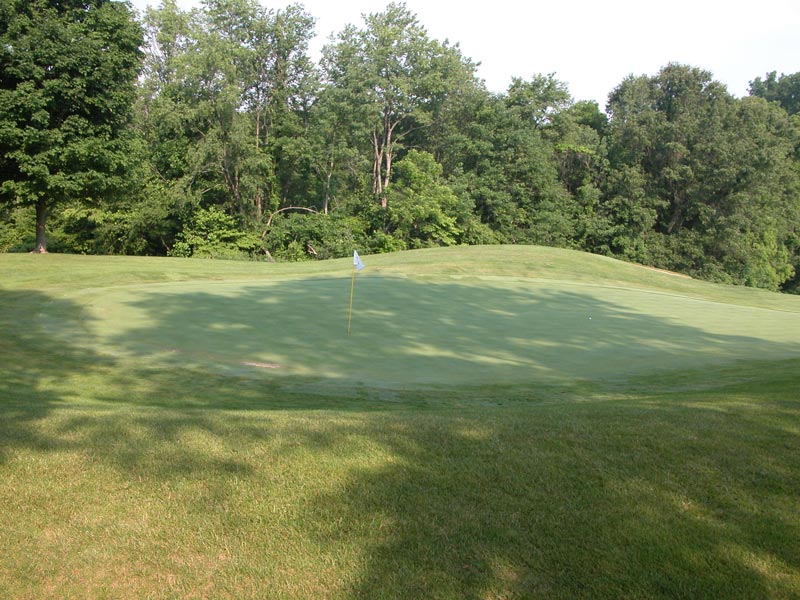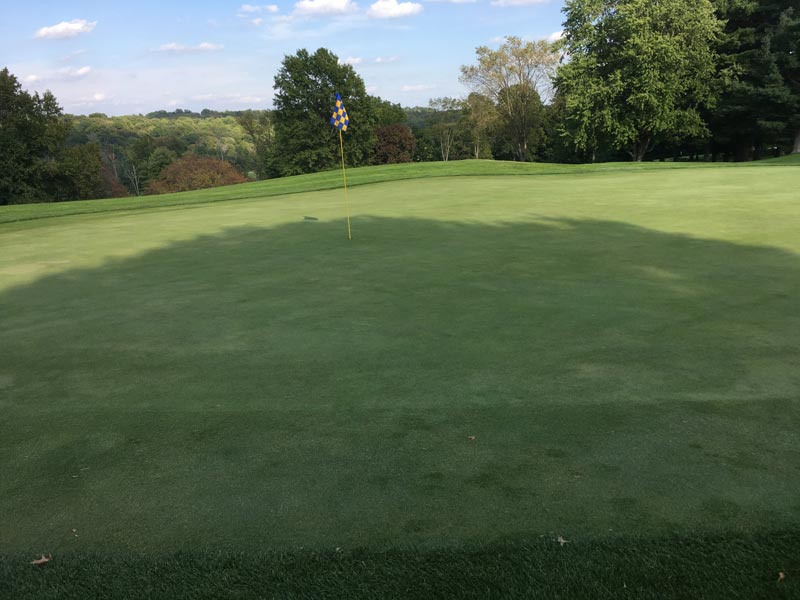
Shade on greens reduces photosynthesis, weakening bentgrass and promoting Poa annua. Photos by Frank Dobie
“Why did you remove that tree?”
Over the years, a few of the members here at The Sharon Golf Club in Sharon Center, Ohio, have asked me this. Tree removal can be a controversial subject, so I decided to document the various potential reasons for removing trees. (I am not advocating for the removal of all the trees — which would make Sharon GC a links-style course — yet there can be numerous practical reasons to eliminate certain trees around a golf course.) Having such a list can be useful when a superintendent is communicating with members.
• Large tree limbs can get broken off during a storm and become lodged in the tree. They can get dislodged during another storm and become a danger to players. If that condition is known and not corrected, it also becomes a financial liability. If the damage is substantial, removing the whole tree may be the best course of action.
• Trees that cast shade on playing surfaces reduce photosynthesis, resulting in weakened bentgrass or bluegrass and promoting Poa annua populations. Morning shade also prolongs wet conditions, which foster fungal diseases.
• Morning shade on greens or tees in late fall allows frost to last longer and delays starting times.
• Trees blocking air movement across a green promote fungal diseases.
• Tree root invasion sucks the moisture and nutrients from the playing surface, resulting in weak, unhealthy turf. Such areas can be hand-watered and given extra fertilization, but these are only temporary measures, as tree roots will outcompete grass plants. Root pruning is another temporary solution that must be repeated every few years.
• Tree roots that invade and plug drainage lines can kill a green by eliminating the natural air draw in the soil when drainage water is blocked.
• Trees that are in line with a shot to a green from a bunker present a double hazard.
• Surface tree roots can cause damage to mowing equipment.
• Surface tree roots can be a danger to a player’s hands or wrists if struck when playing from that lie.
• Trees have a life expectancy and should be removed when they show signs of serious decline — before they can become a hazard.
• Certain tree species are undesirable, such as sweet gum trees, which produce thousands of burr-like pods in spring; wild cherry trees, which tend to have excessive dead limbs that can fall if there’s a strong wind; spruce trees, which have naturally low limbs that offer no relief to a player’s ball; and weeping willows, which have very invasive roots that can plug tiles several hundred feet away.
• Trees can be infected by insects or diseases that have limited or no effective cures, such as emerald ash borer, canker on blue spruce, Diplodia blight on Austrian pine, root rot on eastern white pine, scale and tent caterpillars on flowering crabs, and birch borer on European white birch.
• Trees that have a split in the leader (forked trunk) are at risk of splitting apart in a strong wind storm.
• Trees that are too close together don’t allow either tree to develop into a natural, attractive form.
• Trees that are too close together don’t allow triplex mowing equipment to pass through them, requiring the area to be mowed by hand.
• The higher the population of trees in playing areas, the more labor time must be spent on string-trimming around the bases, spraying for insects and fungus, pruning dead or low-hanging branches, and removing leaves in fall.

Afternoon shade on the ninth green at The Sharon Golf Club.
• Dense, unkempt native stands of trees and underbrush that are in play can contribute to lost balls and slow play.
• Dense stands of trees that are in play can cause so much shade that even shade-tolerant grasses won’t survive, resulting in bare ground and undesirable lies.
• Trees can block scenic views of the course.
• Trees close to bunkers can contaminate them with acorns, burrs, leaves or roots. This is unsightly and warrants additional labor to keep the bunker clean.
• Trees close to paved areas such as paths, patios or parking lots will heave up the asphalt, concrete or bricks, creating a tripping hazard for players.
• Trees that have matured to a certain height and width can block shots from one side of a tee. This causes restricted use of the tee surface and promotes excessive turf wear on the remaining space.
• Certain tree placement can create difficulty solely for high-handicap players and can slow up pace of play.
Trees can add beauty and interest to the golf course landscape, but they can also be a detriment to healthy turf and the safety of players, and can lead to unnecessary expenses. Trees shouldn’t take precedence over playing surfaces.
Frank Dobie is a 60-year member of GCSAA and is the general manager and senior agronomist at The Sharon Golf Club in Sharon Center, Ohio. Frank graduated summa cum laude from Penn State University’s turfgrass management program in 1960. He was the superintendent at Sleepy Hollow Country Club in Brecksville, Ohio, from 1961-1962; the superintendent at Fairlawn Country Club in Akron, Ohio, from 1963-1964; and the superintendent/general manager at The Sharon Golf Club from 1964-2014. He has been in his current position with the club since 2015. Frank has also been the president of the Musser International Turfgrass Foundation since 1988.